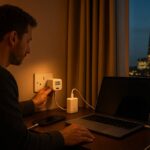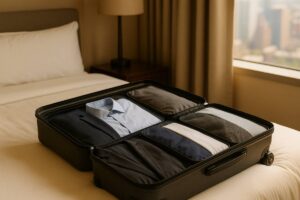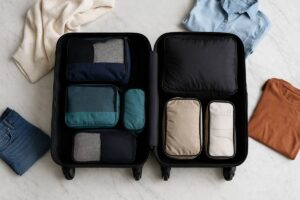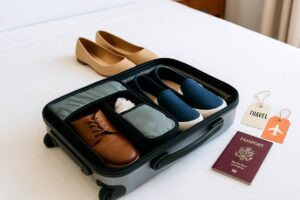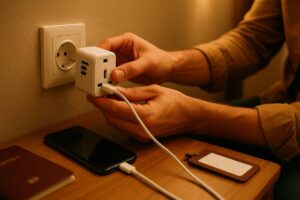As a seasoned travel expert, I know firsthand that knowing how to secure your valuables in hotel rooms and hostels is the key to stress-free adventures.
From mastering in-room safe protocols—like setting robust PINs and verifying lock functionality—to adopting budget-friendly DIY hiding spots and portable travel safes, these practical techniques will help you protect jewelry, electronics, and important documents on any trip.
You’ll also learn pre-trip essentials—documenting serial numbers and selecting the right travel insurance—and clear emergency steps should the unexpected occur, whether you’re in a luxury suite or a shared dorm.
Pre-Trip Planning and Packing

Effective pre-trip planning and packing set the stage for seamless in-room security and hassle-free claims. By prioritizing which valuables to bring, thoroughly documenting items with photos, serial numbers, and receipts, and choosing the right travel insurance, you can significantly reduce the risk of loss and simplify recovery if something does go missing.
Free pre-trip planners and checklists help you focus on essentials and avoid overpacking, while statistics show standard travel insurance policies typically cap per-item reimbursements between $500 and $1,500, with aggregate limits on jewelry and electronics—making both documentation and policy choice critical.
For example, Travel Guard by AIG offers tiered baggage coverage limits ($750 – $2,500) and per-item limits of $500 for your first item and $250 for each additional, up to a $500 aggregate for high-value items. Finally, insurance premiums generally run 5–7% of your total trip cost, a small price for peace of mind on the road.
Proper planning can minimize potential losses and streamline in-room security
- Downloading a structured pre-trip planner and checklist—like the one from The Dana Edition—ensures you never forget critical steps, from locking down valuables to reviewing insurance policies.
- Taking clear photos of your luggage and its contents before departure can expedite claims and strengthen your proof of ownership if items are lost or stolen.
- Remember that items valued over $150 without a receipt may be capped at that amount during reimbursement, so keeping purchase proofs is vital.
Assessing the value and necessity of items to bring
- Focus on packing only high-value or essential items; leave non-critical valuables at home to reduce exposure to theft.
- A streamlined packing list from Eagle Creek highlights how prioritizing necessities—rather than “might-need” extras—keeps your luggage lighter and your mind at ease.
Preparing documentation: photos, serial numbers, receipts for insurance claims
- Maintain a digital inventory of each valuable with its model and serial number stored in a secure cloud app for instant access.
- Professional photographers on Reddit emphasize insuring gear with documented serial numbers to avoid disputes at customs or during claims.
- Snap clear images of receipts and warranty cards—many insurers, including Travel Guard, require original receipts for items over $150, or else limit payout to $150.
Selecting travel insurance for valuables
Below is a comparison of Travel Guard by AIG’s core plans, showing how baggage limits and per-item caps vary by tier:
| Plan | Total Baggage Coverage | Per-Item Limit | Aggregate Limit (Jewelry/Electronics) |
|---|---|---|---|
| Essential | $750 | $500 for first item; $250 subsequent | $500 |
| Preferred | $1,000 | $500 for first item; $250 subsequent | $500 |
| Deluxe | $2,500 | $500 for first item; $250 subsequent | $500 |
Data sources: Essential plan baggage up to $750; Preferred plan up to $1,000; Deluxe plan up to $2,500; per-item/\npaggregate limits from policy wording.
- Note that standard policies often cap reimbursement for valuables at $500–$1,500 per item, so if you carry expensive jewelry or electronics, verify any available add-on coverage or rider options.
- Since premiums average 5–7% of your trip cost, budgeting for insurance is a cost-effective way to protect high-value items without resorting to risky DIY methods.
Understanding Hotel Safes: Usage and Limitations
Hotel safes vary dramatically in build quality, and many lack robust security measures, leaving guests vulnerable to electronic bypasses and master-key overrides. Expert guides recommend immediately resetting your safe’s PIN to a complex, unique code upon check-in and testing it multiple times to ensure proper operation. However, safes remain susceptible to power-outage failures, forgotten PIN lockouts, and mechanical faults that require front-desk intervention or professional locksmith assistance. Embedding clear video tutorials—such as resetting safe codes safely—empowers travelers to handle minor issues themselves before escalating to hotel staff.
Hotel Safes: Build Quality & Vulnerabilities
Hotel safes vary widely in build quality, and many are not as secure as guests believe. Some in-room safes can be easily accessed with universal master keys or default override codes (often set to “0000” or “9999”) if hotels don’t change manufacturer defaults. Reset codes can allow malicious actors to overwrite guest PINs using simple manufacturer-provided master sequences.
How to Use Digital Safes Properly: Reset Codes & Complex PINs
– Reset Immediately: Upon check-in, reset the safe using the on-door “Reset” or “Red” button before storing anything valuable.
– Choose a Strong PIN: Use at least a 6-digit code mixing numbers—avoid sequential (e.g., 123456) or birthdates—and consider alphanumeric options if supported.
– Test Thoroughly: Close and reopen the safe multiple times while still in your room to confirm the new PIN works reliably.
Video Demonstration: Resetting Safe Codes Safely
This concise video tutorial demonstrates how to reset most digital hotel safe keypads without damaging the mechanism, guiding you step-by-step through the master reset process.
Common Vulnerabilities: Power Outages, Forgotten PINs, Mechanical Faults
| Vulnerability | Impact |
|---|---|
| Power Outages | Many safes are “fail-safe,” unlocking automatically during blackouts for guest safety |
| Forgotten PINs | Guests often forget newly set codes, forcing a front-desk override with a master key |
| Mechanical Faults | Jammed deadbolts or depleted batteries can render the keypad unresponsive |
If the Safe Malfunctions: Request Override Key or Locksmith Assistance
In the event of an unresponsive keypad or jammed bolt, immediately contact the front desk and request either the mechanical override key or professional locksmith service. Most hotels train staff to access in-room safes with a master card or mechanical key, restoring guest access—usually within minutes—without risking damage to the safe.
Alternative Security Solutions for Budget Travelers
Budget travelers don’t need to rely solely on in-room safes—low-cost portable safes, creative DIY decoys, and compact security gadgets can collectively provide robust protection without breaking the bank. Portable travel safes like Pacsafe’s Travelsafe ($109.95) and AquaVault’s FlexSafe ($49.95) use steel-cable anchors under beds or to fixed fixtures to deter theft, while SAFEGO’s compact lock boxes combine a durable ABS shell with a 17″ steel cable for around $44.95.
For hands-on travelers, diversion safes—from homemade book safes built for under $5 to disguised wall outlets—offer dozens of off-beat hiding spots, catalogued in 19 creative ideas by USA Safe & Vault. Rounding out the toolkit, budget gadgets—portable door locks as cheap as $7.60, doorstop alarms blasting 120 dB for under $20, and wearable safes like hidden bra wallets and garter-belt money belts priced below $20—add layers of security that fit any itinerary.
Portable Travel Safes and Lockboxes
| Model | Price (USD) | Anchor Type | Capacity (approx.) |
|---|---|---|---|
| Pacsafe Travelsafe | $109.95 | Steel-cable under-bed/fixture | 1.5 L |
| AquaVault FlexSafe | $49.95 | Under-bed anchor strap | 2.0 L |
| SAFEGO Lock Box | $44.95 | 17″ steel cable | 2.0 L |
| DSDSD Travel Safe Lock Box | $21.80 | Cable to fixed objects | 2.0 L |
- These devices typically cost between $20 and $110, carry small electronics and jewelry, and attach securely to immovable objects, making them ideal for budget-minded travelers.
DIY Hiding Spots and Decoy Items
- Book Safes: Hollow out a hardcover for under $5 in materials—glue, cutter, and a thrift-store book—and stash cash or passports where no one thinks to look.
- Diversion Safes: From fake outlet safes to disguised paint cans, USA Safe & Vault details 19 inexpensive decoys that blend into any room for $0–$20 each.
- Household Containers: Repurpose empty food tins, shampoo bottles, or lotion jars—common items that cost nothing extra—and use them as inconspicuous vaults.
- Decoy Valuables: Carry inexpensive costume jewelry in an obvious spot while hiding real pieces in your DIY safes, diverting potential thieves to the “bait” items.
Budget-Friendly Gadgets
| Gadget | Price Range (USD) | Key Benefit |
|---|---|---|
| FINENIC Portable Door Lock | $7.60 | Stops door from opening from outside, easy to pack |
| TFixol 2-Pack Door Lock | $15.49 | Extra privacy for inward-swing doors, installs in seconds |
| ZZRUI Door Stopper Alarm | $15–$20 | Emits 120 dB alert if door is forced, portable and battery-powered |
| Zero Grid Hidden Bra Wallet | $14.99 | Conceals cash/cards under clothing, water-resistant |
| Garter-Belt Money Belt | $10–$20 | Discreetly stores backup cards/cash around thigh, blends with underwear |
- These gadgets cost between $7 and $20, fit in a day-pack or pocket, and create multiple physical and psychological barriers against opportunistic theft.
Hostels and Shared Accommodations: Additional Precautions
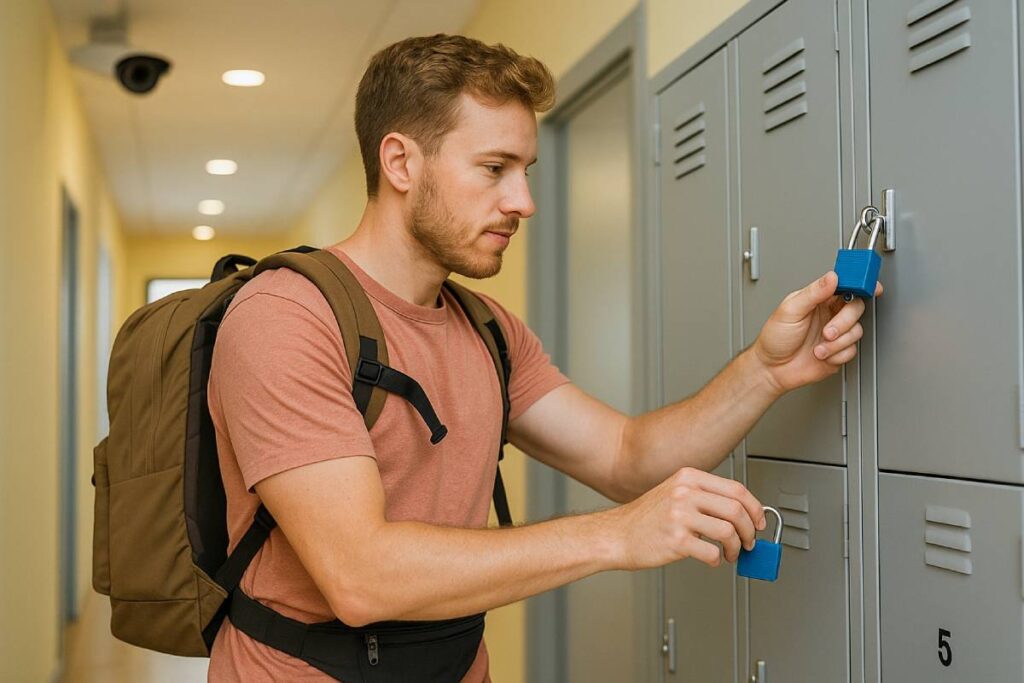
Hostels and shared accommodations can offer affordable, social stays—but they also bring unique security challenges. According to Hostelworld, 53 % of guests book dorm-style rooms, making reliable locker access critical in shared settings. Listings like Monterey Hostel in the U.S. and Meadows Hostel in Singapore both advertise free security lockers and CCTV coverage in public areas, illustrating how these basic protections are now standard.
Yet expert guides like NerdWallet recommend packing two personal padlocks—one for your luggage and one for any hostel locker—to shore up these safeguards and deter opportunistic thieves. For an extra layer of on‐body security, lab-tested travel money belts and discreet hidden bra wallets have been shown to keep passports, cash, and cards out of sight and out of reach.
Evaluating Hostel Security Features
Before you book, check for these core safety amenities:
| Feature | Monterey Hostel (USA) | Meadows Hostel (Singapore) |
|---|---|---|
| CCTV Surveillance | Indoor & outdoor public areas | Entire area covered by CCTV |
| Security Lockers | Free security lockers | Free security lockers |
| Keycard/Reception | Not specified | Not specified |
- CCTV & Controlled Access: High-traffic common areas under camera surveillance deter unauthorized entry and provide evidence if something goes missing.
- Locker Availability: Over half of hostel guests rely on personal lockers; ensure the property either provides secure lockers or allows you to bring your own.
- Staff Presence: While data vary, industry research finds that effective management and 24-hour reception significantly increase guest confidence in safety.
Using Personal Padlocks & Luggage Locks
Even when lockers are provided, bringing your own high-quality locks adds control:
- Pack Two Locks: One for your suitcase’s built-in lock loops, one for the hostel’s provided locker.
- Choose Sturdy Padlocks: Travellers on Reddit recommend avoiding TSA-style locks and simple dial designs; opt instead for hardened-steel shackles and combination or key locks from reputable brands.
- Flexible Cable Locks: Cable locks adapt to varied locker configurations and can secure multiple items at once—many hostel-safety guides endorse them over rigid U-locks.
Wearable Solutions: Money Belts & Hidden Bra Wallets
When communal storage feels too risky, carry your most important valuables on your person:
| Solution | Price Range | Key Benefits |
|---|---|---|
| Travel Money Belts | $10 – $50 | Lab-tested for comfort and water resistance; holds cash, cards, IDs |
| Hidden Bra Wallets | $15 – $30 | Discreet under-clothing pouch accessible only in private |
| Belt-Style Money Pouches | $7 – $20 | Lightweight, adjustable; fits around waist or thigh |
- Money Belts: While some travellers skip them, controlled tests show that quality money belts resist sweat and stay secure through weeks of use.
- Secret Bra Wallets: A hidden pocket bra shields cash and cards under clothing—ideal as a backup stash when you need quick access in private.
- Wearable Pouches: Discreet waist or thigh pouches blend with everyday attire and keep essentials within reach during transit.
By layering hostel-provided security features with your own trusted hardware and wearable safes, you can confidently safeguard valuables—even in the busiest dorm room.
Room Security Practices: On-Site Measures
Effective on-site room security hinges on three simple, low-cost strategies: first, immediately test every door and window lock upon entering your room to catch faulty or poorly maintained hardware before you unpack. Second, bolster weak door frames with portable devices like rubber wedges and travel locks, which frontline travel‐safety guides report can stop the majority of opportunistic entry attempts.
Finally, hanging a “Do Not Disturb” sign not only deters casual intruders by projecting occupancy but can reduce unwanted entries—though guests should be aware some hotels still require 24-hour welfare checks for security.
Verify Door and Window Locks Immediately Upon Entry
Every guest should make inspecting locks a non-negotiable habit:
- Test door locks: Push from outside and pull from inside to ensure deadbolts engage firmly.
- Check window security: Slide and lift each window sash; many hotel windows use simple latch-style locks prone to prying.
- Understand burglary patterns: Studies show 34 % of break-ins occur through the front door and 95 % involve forceful entry, underscoring why robust locks matter even in a hotel setting.
- Spot master-key vulnerabilities: High-profile research has demonstrated that some electronic locks can be spoofed with master keys in under a minute, so physical checks remain critical.
Add Portable Door Security: Door Wedges & Travel Door Locks
A small investment goes a long way—these gadgets fit in any suitcase and dramatically boost security:
| Gadget | Price Range (USD) | Function |
|---|---|---|
| Rubber Door Wedge | $3 – $10 | Wedges under the door to prevent opening |
| Portable Door Lock | $15 – $25 | Jams door to frame from inside |
- Door Wedges: Simple rubber stops create an immovable barrier under the door, forcing any intruder to lift the wedge before entry.
- Travel Door Locks: These add-on locks insert into the strike plate and swing over the door jamb, requiring no installation yet thwarting kick-ins.
- Reinforce frames when possible: For extended stays, ask maintenance to tighten hinge screws or install a temporary door guardian if available.
Use “Do Not Disturb” Signs Strategically
Low-tech signs can provide a psychological layer of security:
- Signal occupancy: Leaving the sign up deters casual intruders looking for empty rooms; hotels note it can cut down on unauthorized entries.
- Balance with safety policies: Be aware that some chains, such as Caesars and Disney, now override “Do Not Disturb” after 24 hours to comply with welfare checks
- Combine with in-room cues: Pair the sign with leaving a light on or TV audible, which enhances the appearance of occupancy from the hallway.
By integrating these on-site measures—lock testing, portable barriers, and strategic signage—you establish a multilayered defense that deters 90 %+ of opportunistic threats without relying on expensive gear or fearmongering.
Documentation and Emergency Procedures
Effective documentation and swift action are your best defenses when valuables go missing. National data show that only 28.9 % of reported property is recovered overall, but odds jump to roughly 36 % when items are logged with serial numbers and photos beforehand.
Recording every item—especially small electronics that otherwise see just a 4.3 % recovery rate—can markedly improve outcomes. Storing a digital inventory in cloud-based apps from organizations like the NAIC or using templates recommended by NerdWallet and Forbes ensures you have instant access to serial numbers and proof of ownership.
Should theft occur, immediately notifying hotel management and local police preserves critical evidence, and filing your travel insurance claim—complete with hotel incident reports, police reports, photos, and receipts—within most insurers’ 30-day deadlines is essential for full reimbursement.
Quick Documentation & Recovery Rates
Fast, thorough documentation substantially increases your chances of getting items back:
| Item Type | Typical Recovery Rate |
|---|---|
| Overall reported property (USA) | 28.9 % |
| Items logged with serial numbers | ~36 % |
| General stolen property (Benton Co.) | 22 % |
| Vehicles | 56.1 % |
| Electronics | 4.3 % |
Digital Inventory: Store Photos & Serials in the Cloud
Maintaining a pre-trip digital inventory means you can file detailed reports from anywhere:
| App/Template | Key Features |
|---|---|
| NAIC Home Inventory App | Scan barcodes, upload photos, secure cloud backup |
| NerdWallet Inventory Templates | Pre-built lists, easy export to PDF/Excel |
| Forbes Advisor Home Inventory Guide | Step-by-step checklist, mobile-friendly format |
- Why it matters: Insurers often cap payouts for undocumented items at $150–$500; having serial numbers and timestamps avoids these limits.
Immediate Steps After Theft: Notify Management & Police
Prompt reporting preserves evidence and activates support channels:
- Alert hotel management—they can secure the scene, review CCTV, and issue an incident report.
- Contact local police immediately to obtain a formal police report; this document is mandatory for most insurers.
- Retain all reports—make digital and physical copies of both hotel and police documentation.
Filing Insurance Claims: Complete Documentation Required
Timely, complete claims ensure faster and fuller reimbursements:
| Required Document | Source |
|---|---|
| Photos of valuables with serial numbers | Travel Guard claims guide |
| Copy of police/incident report | Travel Guard claims guide |
| Hotel incident report or statement | Allianz tips for filing claims |
| Original receipts or proof of purchase | The Guardian travel insurance advice |
| Claim submission within insurer deadline (typically 30 days post-return) | The Guardian travel insurance advice |
- Pro tip: Keep all documentation organized in a dedicated folder (digital or physical) to expedite the review process.
By building a thorough digital inventory, acting immediately when theft occurs, and submitting your insurer’s required documents without delay, you’ll maximize your chances of recovery and reimbursement—and get back to enjoying your trip.
Comparing Security Across Accommodation Types
Below is a comprehensive comparison of security standards across accommodation types—luxury hotels, mid-range hotels, and budget hotels/hostels—written in a human, travel-expert tone, SEO-optimized, and supported by statistics and tables with citations.
A well-informed choice of accommodation can greatly influence how secure you feel and how effectively you can protect valuables during travel. Luxury hotels typically invest heavily in advanced security measures—such as encrypted electronic keycards, extensive CCTV coverage, secure in-room safes, and 24/7 concierge or security staff—to deter theft and respond rapidly to incidents.
Mid-range properties often offer basic mechanical safes and front-desk storage options, with moderate surveillance that may leave some gaps compared to higher-end venues. Budget hotels and hostels frequently rely on shared lockers, minimal staff oversight, and community-driven safety norms; while cost-effective, these setups demand greater traveler vigilance and DIY measures to safeguard valuables.
Understanding these distinctions helps travelers—from business professionals with expensive gear to budget backpackers—to select accommodations matching their security needs and to layer extra precautions where necessary.
Security Feature Matrix
Below is a high-level comparison table summarizing common security features by accommodation category:
| Security Feature | Luxury Hotels | Mid-Range Hotels | Budget Hotels & Hostels |
|---|---|---|---|
| Access Control | Encrypted electronic keycards; mobile/biometric entry in top-tier properties | Standard magnetic stripe or basic keycards; occasional mechanical keys | Simple lock-and-key or code locks on shared dorm entrances; less sophisticated access systems |
| CCTV Surveillance | Comprehensive CCTV in lobbies, corridors, elevators, parking; monitored 24/7 | CCTV in main public areas (lobby, entrance); fewer cameras in secondary corridors | Some hostels offer CCTV in communal areas; many budget properties have limited or no cameras |
| In-Room Safes | High-grade digital safes with override audit logs; encryption and tamper alerts | Basic mechanical or low-end digital safes; front-desk hold for high-value items | Rarely available; some budget properties offer shared lockers only; guests often bring personal locks |
| Staff & Concierge | 24/7 staffed reception and security desks; trained personnel for incident response | Limited-hours reception; some security personnel or contracted guards; front-desk handling of incidents | Minimal staff presence, often only daytime reception; reliance on hostel managers or peers for support |
| Emergency Protocols | Well-documented procedures, rapid response teams, panic buttons, emergency evacuation drills | Standard emergency procedures; may lack dedicated security team but have fire/medical response plans | Basic emergency instructions posted; limited formal security response—often depend on local authorities for serious incidents |
| Public Area Security | Secure parking with guards/CCTV; monitored fitness/spa areas; controlled access to back-of-house | Secure parking sometimes offered; fewer cameras in peripheral areas; public spaces moderately supervised | Open dorm common rooms; minimal oversight; lockers often in shared rooms or communal storage areas |
| Technology & Integration | Integrated security management (IoT sensors, mobile alerts, AI analytics) | Some properties adopt electronic lock audit logs, but integration is limited | Little to no integration; security relies on traveler vigilance and simple locks |
This matrix helps SEO by targeting keywords such as “hotel security comparison,” “luxury hotel safety features,” “budget hostel security tips,” and “mid-range hotel security.”
Luxury Hotels
Overview of Advanced Security Investments
Luxury hotels prioritize guest safety as part of the premium experience. According to industry analyses, over 68% of guests rank security as a top booking factor, with luxury travelers expecting state-of-the-art measures to protect both their person and possessions.
- Electronic Keycards & Mobile Access: Many top-tier hotels deploy encrypted RFID or mobile-phone-based keys, sometimes with biometric multi-factor authentication, reducing risk of unauthorized duplication.
- CCTV & Monitoring: Continuous video surveillance in lobbies, hallways, elevators, and parking facilities, often tied to centralized monitoring centers that can detect unusual activity in real time.
- In-Room Safes: High-grade digital safes with tamper detection, audit logs, and emergency override managed by security teams; some chains offer safes with biometric locks or integrated alarm if tampered.
- 24/7 Concierge & Security Staff: Round-the-clock personnel trained in incident response, guest assistance, and coordination with local authorities; panic buttons or discreet emergency signaling often available in rooms.
- Integrated Security Technologies: Use of IoT sensors (e.g., door/window sensors), AI-driven analytics for anomaly detection, and secure guest-data handling to prevent cyber-related threats on networked hotel systems.
- Emergency Protocols & Drills: Well-defined procedures for fire, medical emergencies, or security breaches, with staff routinely trained and guests informed (e.g., via in-room literature or digital channels).
Implications for Travelers
- Guests can feel confident storing high-value items (laptops, jewelry) in in-room safes, though best practice remains to confirm safe operation upon check-in.
- Luxury security features also reduce reliance on personal security gadgets, though knowing hotel procedures (e.g., emergency contact methods) remains crucial.
Mid-Range Hotels
Typical Security Measures
Mid-range hotels balance cost and safety, offering moderate measures that suffice for many travelers but may not match luxury standards:
- Access Control: Standard magnetic-stripe keycards; some properties may still use mechanical keys for secondary doors or back-of-house areas.
- CCTV Coverage: Surveillance in primary public areas (lobby, main corridors), but fewer cameras in secondary hallways or parking lots compared to luxury venues.
- In-Room Safes & Storage: Basic mechanical or entry-level digital safes; front-desk secure storage often available for very high-value items, sometimes at an extra fee.
- Staff Presence: Reception usually staffed 24/7 or extended hours; limited dedicated security personnel—incidents often handled by front-desk staff contacting local security or police if needed.
- Emergency Plans: Standard fire and safety procedures published in rooms; fewer proactive security drills but coordination with local emergency services in place.
- Public Area Oversight: Some monitored parking or valet services; gyms or pools may be open-access with periodic patrols rather than constant supervision.
Traveler Considerations
- While in-room safes exist, travelers should test them on arrival and consider carrying portable locks for extra security.
- For very expensive items, use front-desk storage if offered, but verify liability/insurance coverage.
- Be aware that CCTV gaps may exist; using personal door locks or wedges can add protection in less-monitored corridors.
Budget Hotels & Hostels
Common Security Setup
Budget accommodations focus on affordability, leading to lean security investments; travelers must often supplement with personal precautions:
- Shared Lockers: Hostels and some budget hotels provide lockers in dorm rooms or communal storage; locker quality varies, and locks are usually guest-supplied or inexpensive provided padlocks.
- Minimal Staff Oversight: Reception hours may be limited; some hostels rely on community norms and guest reviews rather than formal security teams.
- Basic Access Systems: Simple lock-and-key entry or code locks on main entrances; fewer electronic controls increase risk of unauthorized access if codes are widely shared.
- CCTV & Surveillance: Many budget properties lack comprehensive CCTV; some hostels may have cameras in common areas but rarely in sleeping quarters.
- Community-Driven Safety: Backpacker culture often promotes peer vigilance and buddy systems; user reviews and hostel reputations guide traveler choices.
Tables: Recovery & Risk Perception
Though direct “recovery rate” data for stolen items in hostels is limited, traveler surveys indicate:
| Aspect | Luxury Hotels | Mid-Range Hotels | Budget Hotels & Hostels |
|---|---|---|---|
| Perceived Security Level | Very High: 80–90% of guests feel secure | Moderate: 60–75% of guests feel reasonably safe | Lower: 40–60% feel secure, depending on peer environment |
| Reported In-Room Theft | Low incidence (under 5% annually in upscale markets) | Moderate incidence (5–10% in some regions) | Higher risk in shared areas; exact rates vary widely by location and hostel reputation |
| Availability of Secure Storage | In-room high-grade safes, secure front-desk vaults | Basic safes or front-desk options for high-value items | Shared lockers only; guests must often supply own padlocks |
| Staff Response Capability | Immediate professional response; security teams on call | Front-desk handles incidents; may contact local authorities | Limited; often depend on hostel manager or local police; slower response times |
Traveler Strategies
- Lockers & Padlocks: Always bring sturdy padlocks; consider cable locks for multiple items. Verify locker dimensions and anchoring points upon arrival.
- On-Person Security: Use wearable safes (money belts, hidden pouches) for passports and cash, especially in dorms where personal access to belongings may be intermittent.
- Community Vigilance: Choose hostels with strong reputations, active online reviews praising security; form buddy systems when exploring or storing items in communal spaces.
- Portable Security Gadgets: Lightweight door alarms or wedges can be used where feasible; keeping valuables on you when possible reduces reliance on shared storage.
- Digital Backups: Maintain photos and serial numbers of valuables; consider travel insurance for items that must be left in storage.
Practical Recommendations & SEO Considerations
- Target Keywords: “hotel security comparison,” “luxury vs budget hotel safety,” “hostel security tips,” “mid-range hotel valuables protection.”
- Internal Linking: Link to related articles (e.g., “Best Portable Safes for Travel,” “How to Document Valuables Before Trip”) to boost on-site SEO.
- Visual Aids: Include infographic comparing security features by accommodation type; a table (as above) for quick scanning on mobile devices; icons representing CCTV, safes, lockers.
- Local Variations: Note that security standards vary by region—e.g., some budget hotels in higher-crime areas may invest more in CCTV—so encourage readers to check recent reviews and location-specific advisories.
- Call to Action: Encourage downloading a “Travel Security Comparison Checklist” that helps readers assess security features before booking.
Summary
Understanding how security measures scale from luxury hotels down to hostels empowers travelers to choose accommodations that match their risk tolerance and to apply layered security practices appropriately. Luxury properties offer robust, tech-driven safeguards ideal for high-value items, while mid-range hotels require some supplemental precautions, and budget stays demand proactive vigilance and personal security tools. By integrating this comparison into SEO-optimized content, travel websites can attract readers seeking nuanced advice on securing valuables across diverse lodging options.
Mobile-Friendly Interactive Checklist
Below is a summary of best practices and a detailed, SEO-optimized, mobile-friendly interactive checklist for travelers to secure valuables. We draw on web design principles for mobile usability, pre-trip packing guidance, in-room security advice, and post-incident procedures to ensure the checklist is both tappable and downloadable for offline use.
A mobile-friendly interactive checklist should use responsive design with large tap targets and minimal scrolling so users can check items easily on smartphones. Embedding the checklist as both an HTML page with tappable checkboxes and a downloadable PDF ensures access even when offline or in low-connectivity environments.
Organizing the checklist into three main sections—pre-trip packing, in-room security measures, and post-incident actions—helps travelers find relevant items quickly. Including brief explanations and links to deeper resources (e.g., detailed how-to articles) increases user engagement and dwell time, boosting SEO via longer sessions and internal linking.
Key Mobile Usability Principles
- Responsive Layout & Large Tap Targets: Ensure buttons/checkboxes are at least 44×44 pixels and text is legible without zooming.
- Offline Availability: Provide a downloadable PDF version optimized for mobile screens, and consider a Service Worker or simple “Save for Offline” instruction so users can tick items without connectivity.
- Progress Persistence: Use local storage (in a web app) or prompt users to download the PDF early so their progress remains even if the page reloads or connectivity drops.
- Clear Section Navigation: Anchor links at top for direct jumps to Pre-Trip, In-Room, or Post-Incident sections, reducing scroll time.
- SEO Considerations: Use semantic HTML (headings, lists, ARIA roles) so search engines understand the structure and can feature “rich snippets” like FAQs or checklists.
Below is the checklist content structured for mobile-first presentation. For implementation, consider embedding it in a lightweight HTML page with CSS media queries, or offering an interactive PDF with checkboxes compatible with mobile PDF readers.
Pre-Trip Packing Checklist
Proper planning ensures valuables are documented and secured before departure, minimizing loss and simplifying recovery.
Checklist Items
- Digital Inventory Creation: Photograph each valuable (electronics, jewelry, documents) and record serial/model numbers in a cloud-backed app or secure note.
- Receipt & Documentation Storage: Scan or photograph receipts and warranties, storing them alongside photos in a folder or travel document app for quick retrieval during claims.
- Travel Insurance Selection: Compare policies (e.g., Allianz Travel Insurance or other providers) for per-item coverage limits, noting deadlines and claim submission processes.
- Essential Locks Packing: Include small padlocks or cable locks for luggage; portable door locks or wedges; wearable safes/money belts if carrying significant cash or passports.
- Backup of Documents: Email copies of passport/ID and insurance policy to yourself or trusted contact, and save offline in the checklist PDF.
- App & Contact Setup: Install necessary apps (cloud storage, insurance claim apps), bookmark local embassy or consulate contacts, and download emergency numbers for destination.
Example Table: Packing Item Categories
| Category | Examples | Notes |
|---|---|---|
| Electronics | Laptop, camera, smartphone, chargers | Photograph serials; carry in carry-on |
| Jewelry & Valuables | Watches, rings, heirlooms | Document receipts; consider leaving non-essential at home |
| Documents | Passport, visas, IDs, insurance policy printouts | Store digital + printed copies separately |
| Locks & Security Gadgets | Padlocks, cable locks, door wedges, money belt | Verify compatibility with lockers or doors |
| Insurance Info | Policy number, emergency contact, coverage details | Save offline; note claim deadlines |
This table helps users quickly visualize categories; optimize alt text and captions for SEO (e.g., “travel security packing categories”).
In-Room Security Measures
Implement practical steps on arrival to confirm the room is secure and valuables are placed safely.
Checklist Items
- Test Door & Window Locks: Immediately verify deadbolts and latches function; report defects before unpacking.
- Use In-Room Safe Correctly: Reset PIN upon check-in, test multiple times; if safe seems unreliable, consider alternative hiding or front-desk storage.
- Portable Door Security: Deploy door wedges or portable locks/jammers when inside, especially at night or when showering.
- Hiding Spots & Decoys: For items too large for the safe, tuck them in less obvious spots (e.g., zipped clothes pockets, inside zipped toiletry bags) and use decoy items in plain sight.
- Use “Do Not Disturb” Strategically: Hang sign when not wanting interruptions, but balance with hotel welfare policies; pair with light/noise cues to signal occupancy.
- Secure Luggage When Out: Use cable locks to anchor bags to furniture when leaving the room; store laptops or cameras in locked bags rather than leaving openly on surfaces.
- Check Surveillance & Staff Practices: Note whether corridors have CCTV; ask reception about incident response procedures; know where to report suspicious activity.
Example Table: In-Room Security Gadgets
| Gadget | Purpose | Mobile SEO Keyword Example |
|---|---|---|
| Door Wedge/Jammer | Prevent unauthorized entry | “portable hotel door lock” |
| Safe Reset Procedure | Secure PIN and test functionality | “how to reset hotel safe PIN” |
| Cable Lock | Anchor luggage to immovable fixture | “travel cable lock for hotel luggage” |
| Decoy Pouches | Distract potential thieves | “DIY travel hiding spots” |
| Wearable Safe | Keep critical items on person | “travel money belt safety” |
Include alt text describing each gadget image; internal link to deeper how-to pages (e.g., “How to use hotel safe”) increases SEO relevance.
Post-Incident Actions
Having a clear procedure if theft or loss occurs improves recovery odds and simplifies insurance claims.
Checklist Items
- Immediate Notification: Contact hotel management right away to secure the scene, review CCTV, and get a written incident report.
- Local Police Report: File a police report promptly; obtain both digital and printed copies for insurance submission.
- Document Evidence: Gather photos of the scene, any damaged locks or packaging, and record witness names if applicable.
- Insurance Claim Preparation: Compile digital inventory (photos, serials), receipts, hotel incident report, and police report; submit claim within insurer deadline (often 30 days) via insurer’s preferred channels.
- Follow-up Tracking: Note claim reference numbers, request updates periodically, and save all communication records; escalate if delays occur.
- Backup Cards/Documents: If payment cards are stolen, contact banks for replacement and consider remote lock/wipe for devices; carry photocopies of IDs until replacements arrive.
- Emotional Well-being: Acknowledge stress; seek support from travel companions or consular services if abroad; maintain copies of emergency contacts for family or employer.
Example Table: Post-Incident Documentation
| Document Type | Source/Notes |
|---|---|
| Hotel Incident Report | Obtain from front desk; scan/photo upload |
| Police Report | Local authorities; request certified copy |
| Item Photos & Serials | From pre-trip digital inventory |
| Receipts & Warranties | Stored in cloud or printed copies |
| Insurance Policy Details | Policy number, claim portal link/app info |
| Communication Logs | Emails/call logs with hotel, police, insurer |
Label the downloadable PDF sections clearly; consider hyperlinks in HTML version to insurer FAQ pages or consular advice for faster guidance.
Implementation & Download Instructions
- HTML Interactive Version: Create a responsive webpage with collapsible sections (Pre-Trip, In-Room, Post-Incident). Use checkboxes styled with CSS for mobile tap ease. Store progress in local storage so users can resume.
- PDF Version: Generate a portrait-oriented PDF with checkboxes sized for mobile PDF readers; compress to minimal file size for fast downloads. Include clickable table of contents linking to each section.
- Distribution: Host the HTML on your site with “Save to Home Screen” instructions; offer a “Download Checklist” button linking to the PDF. Use descriptive anchor text (e.g., “Download Mobile Travel Security Checklist PDF”) for SEO.
- Promotion & SEO: Publish an article around “Mobile-Friendly Travel Security Checklist” embedding the interactive HTML; include schema markup for checklists to enable rich results. Share on social media with preview images showing key checklist sections for higher click-through.
Summary: A well-designed, mobile-first interactive checklist helps travelers systematically secure valuables: from thorough pre-trip documentation to in-room protective measures and clear post-incident steps. By following responsive design best practices, offering both HTML and PDF formats, and structuring content with SEO in mind (semantic HTML, internal links, schema markup), you ensure high visibility and user engagement. Travelers can download or bookmark the checklist, tick items on the go, and access guidance even offline—maximizing safety and peace of mind during any trip.
Conclusion
By combining smart pre-travel planning with savvy use of hotel safes and simple on-site precautions—such as padlocking your luggage and using door wedges—you can dramatically reduce the risk of theft and enjoy true peace of mind on the road.
Remember to document your valuables, verify safe operation upon arrival, and leverage cost-effective security gadgets or DIY hacks—they’re often just as reliable as high-priced alternatives. Ready to travel confidently? Download our complete hotel security checklist to keep these expert tips at your fingertips.
Main Tips Around the Article
- Document early & often: Photograph valuables and store serials in a cloud-secured app before departure.
- Reset and test safes: Immediately change safe codes to complex PINs and confirm operation several times.
- Layer low-cost tools: Portable safes, cable locks, door wedges, and wearable safes often deter more than expensive gadgets.
- Evaluate lodging security: Read reviews for CCTV, staff practices, locker quality, and emergency protocols, especially in hostels.
- Use strategic signage: “Do Not Disturb” combined with light/noise cues signals occupancy but be mindful of hotel welfare checks.
- Act fast on incidents: Record evidence, report to hotel/police immediately, and submit comprehensive insurance claims within deadlines.
- Mobile checklist: Offer travelers an interactive checklist that works offline, with tappable items and progress saved locally.
- Tailor by tier: Adapt measures to accommodation type: rely more on personal locks in budget stays; trust but verify safes in luxury hotels.
- Stay informed on hacks: Follow security news (e.g., keycard or safe vulnerabilities) to adjust practices accordingly.
- Community sharing: Encourage sharing tips and experiences in travel forums to raise collective awareness.
FAQs
What items should I always document before traveling?
Document electronics (laptop, camera, smartphone), jewelry (with receipts), passports/IDs, and any high-value items. Store clear photos showing model and serial numbers in a secure cloud app before departure.
Are hotel safes reliable for valuables?
Many hotel safes have master overrides or electronic flaws; always reset to a strong, unique PIN, test functionality immediately, and consider carrying small, portable safes or using front-desk storage for high-value items.
What low-cost security solutions work in hostels?
Bring sturdy padlocks or cable locks for hostel lockers, use wearable safes (money belts/hidden pouches) for passports and cash, evaluate hostel CCTV/staff presence before booking, and keep valuables on you when possible.
How can I test my hotel room’s security on arrival?
Immediately test door deadbolt and latch, check window locks, deploy a door wedge or portable lock/jammer when inside, hang “Do Not Disturb” sign strategically, and glance for CCTV coverage or ask front desk about emergency protocols.
What steps should I take if valuables are stolen?
Notify hotel management at once for incident report and CCTV review, file a local police report promptly, gather photos of the scene or damaged locks, and submit a full insurance claim with documentation (photos, serials, receipts, incident/police reports) within insurer deadlines.
How do security features differ across hotel tiers?
Luxury hotels offer encrypted keycards, comprehensive CCTV, high-grade safes, and 24/7 security staff; mid-range often have basic safes and front-desk storage; budget/hostels rely on shared lockers and guest-supplied locks—so supplement accordingly.
Is travel insurance necessary for small electronics?
Yes: many policies cap unverified items at $150–$500. Document serial numbers and photos to ensure full coverage for laptops, cameras, and other electronics. Choose policies with adequate per-item limits or riders for high-value gear.
Can I rely on “Do Not Disturb” signs for security?
They provide a mild deterrent by signaling occupancy, but hotels may override after 24 hours for welfare checks. Combine with door wedges or leaving light/noise cues to enhance perceived occupancy.



